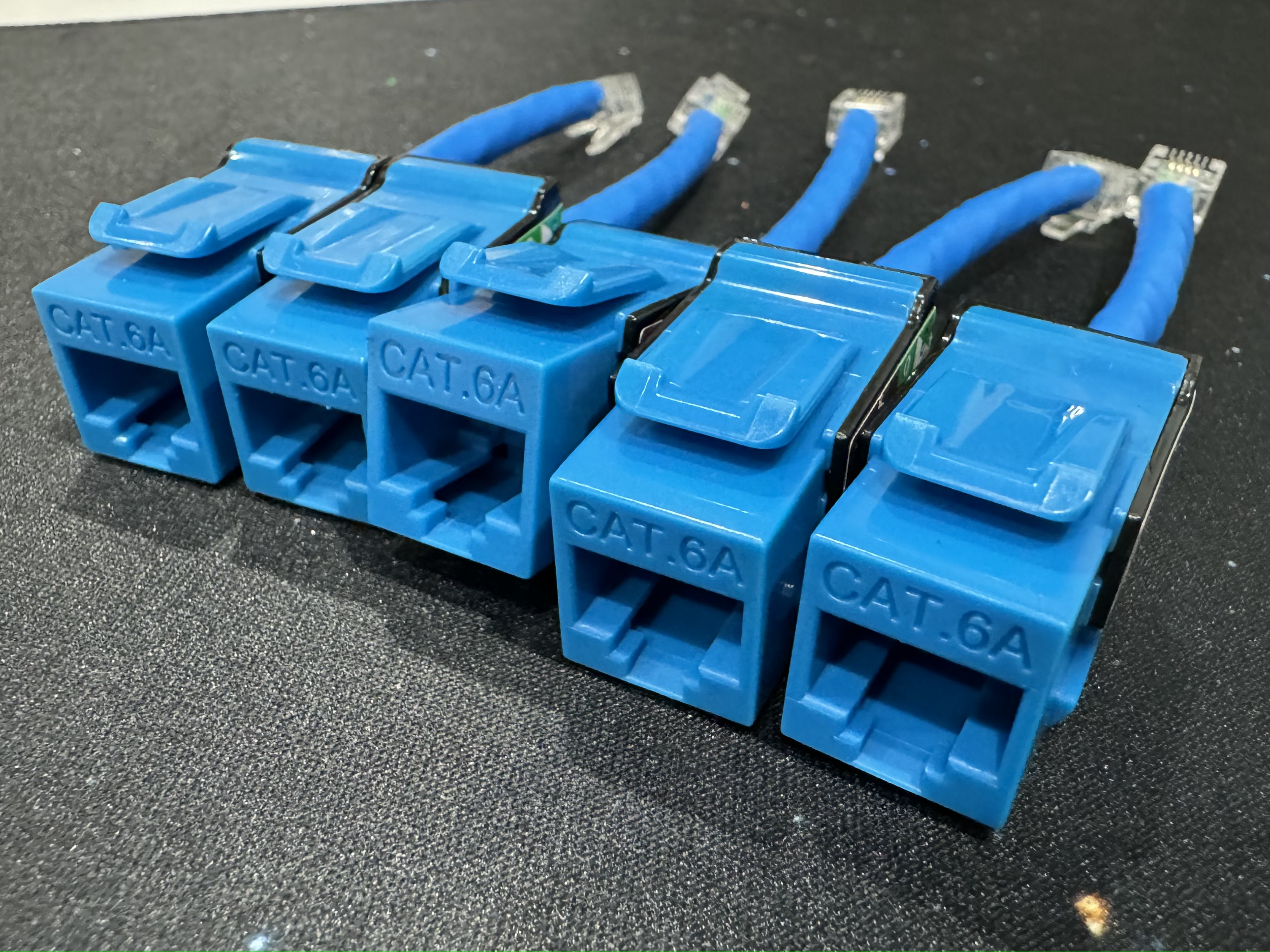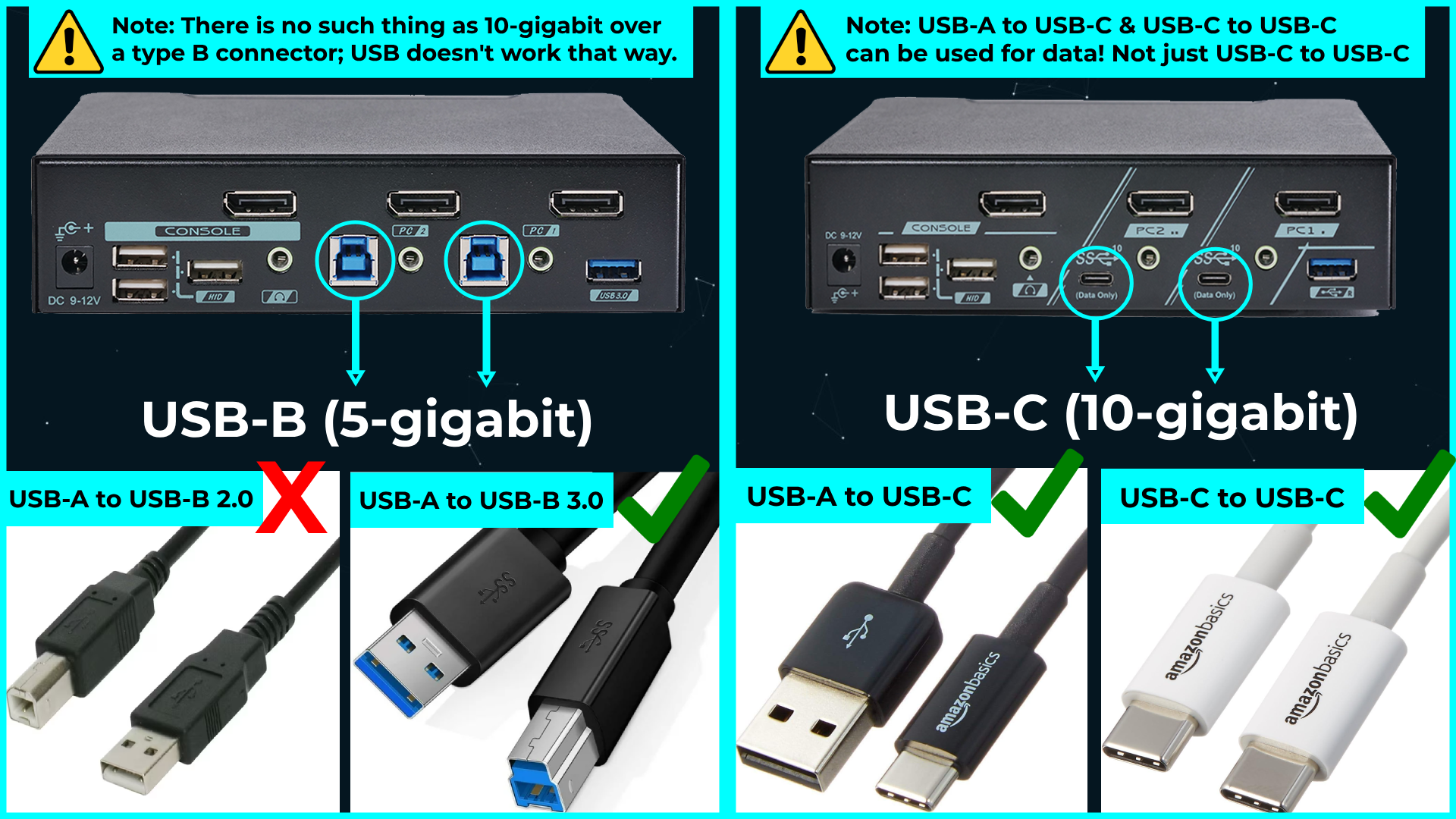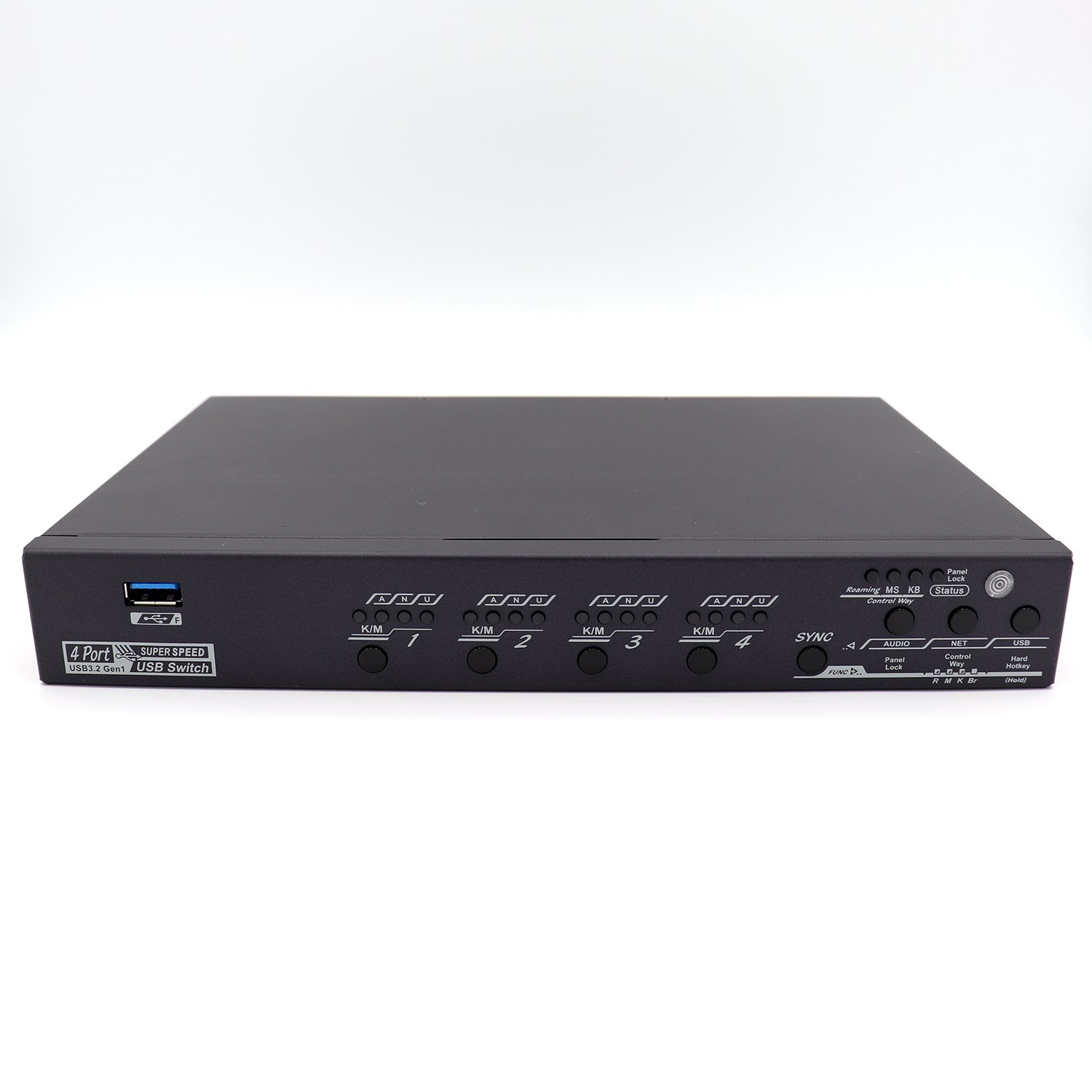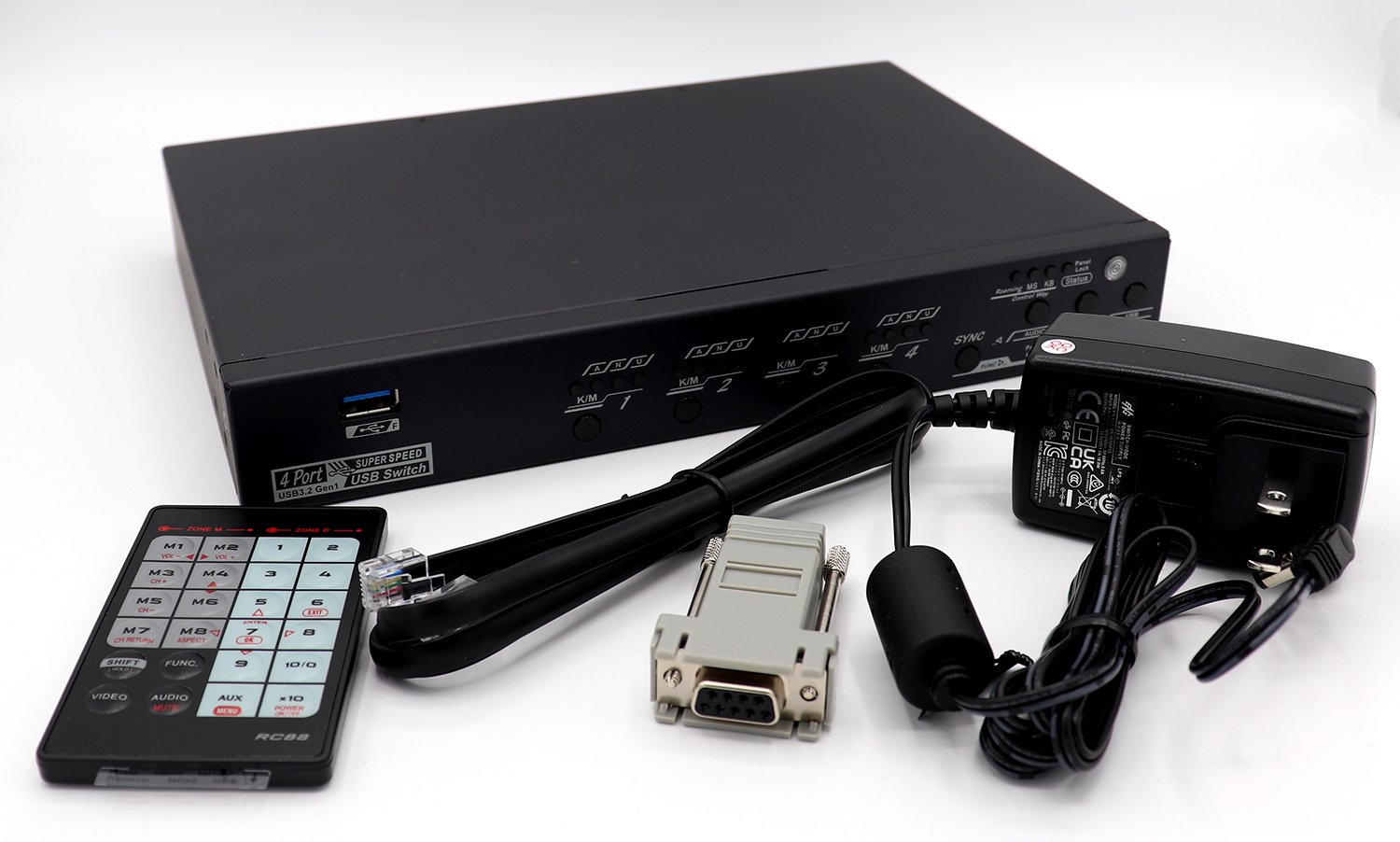(B-STOCK) USB-C KVM Switch v2 (with USB Power Delivery / 70watts)
For technical support or questions regarding KVMs and their accessories that are not answered in the product description below, please submit a support ticket.
These are "B-Stock" of the L1T USBC v2 KVMs:
They are rated up to 4K@60Hz.
All have been tested to ensure they work correctly, however the KVMs may have minor cosmetic damage (scuffs, dings, etc.)
Packaging may have tearing or other defects.
This KVM switch will let you ONE DisplayPort monitor plus other USB peripherals like a keyboard and a mouse between up to two USBc devices such as a laptop and an ipad, two laptops, or a laptop and a desktop.
It has also been tested to be compatible with Samsung DEX, assuming your display is also compatible.
INPUTS:
1 USBc input from each of two computers (USB + DisplayPort signal on one wire)
OUTPUTS:
Displayport 1.2 (see note)
4x USB HID
2x USB 3.1 gen 1 5gbps
3.5mm Audio Microphone
3.5mm Audio Headphone
CONTROLS:
USB Mode: 5gbps USB3 (uses 25% of DisplayPort bandwidth)
USB2 mode (prioritize DisplayPort bandwidth)
Power Mode: Control how many amps to which USBc Port
Note: the KVM uses USB and DP input on the same USBc connector. It is not thunderbolt, but often thunderbolt ports can fallback to USB + DP on one USBC connection. Sharing USB and DisplayPort on the same USBc cabling will limit the total bandwidth of the cable.
Unfortunately, it is not possible to support the full bandwidth AND USB 5gbps speeds with just one wire. So, we give you the option. At the back of the KVM is a switch that lets you pick between USB3 and USB2 speeds. This switch prioritizes DisplayPort bandwidth or USB bandwidth, in other words.
Even with that switch we do not recommend this KVM for resolutions and refresh rates beyond 5k/75hz. It is possible to run lower resolutions with higher refresh rates -- 120hz @ 1440p has been well-tested, as well as 4k @ 90hz from a desktop gaming computer.
The KVM will not work with *just* a USBc USB connection. The device you are connecting to the KVM via USBc must be from a USBc port that does USB+DisplayPort such as on the RTX 2080Ti, Some Radeon 6800 series GPUs and desktops that have a displayport input for thunderbolt passthrough.
I do have a few reports of folks using a VR cable like the Belkin Charge And Sync cable to go from USB + DP on a desktop PC to USBc and.. theoretically.. that would work here, too.
In addition we recommend you use short high quality USBc cables that are rated for both USBc and DisplayPort signals.
It is possible to feed the output of this KVM into another level1techs kvm so that you can have “native” USBc devices on your kvm.
In general, most KVM switches are meant to work with servers, and basic mice and keyboards.
This KVM switch will work with USB 3.0 (USB 3 5gbps, or USB 3.2 gen 1) peripherals as well as USB 2.0 HID devices.
It has also been tested to work with high-end RGB gaming keyboards like keyboards from Corsair, Cougar and more.
It has been tested with keyboards that have built-in USB hubs as well as USB passthrough. I use it with an IBM Model M modified to use QMK firmware, with nkey rollover disabled, and it works great.
While we don’t recommend USB switching with mass storage devices (!!??), it is possible. It will also let you share peripherals like scanners and printers through USB (note: Maximum 1A power through USB connections).
The included power brick is auto-sensing 100-240 volts, 70 watts output, 19~21 volts DC, center positive. The box includes a US-style power cord, but any "local" NEMA 5-15P power cord (computer power cord) can be used for your region, nothing special is required.
If you have any technical pre-sales questions, reach out to wendell, email above. If you run into problems please email before returning. These are a labor of love and we are keen to iterate and improve every generation of product.
These USBc KVMs with power delivery are a second generation product. Many lessons-learned incorporated into this new model.
For technical support or questions regarding KVMs and their accessories that are not answered in the product description below, please submit a support ticket.
These are "B-Stock" of the L1T USBC v2 KVMs:
They are rated up to 4K@60Hz.
All have been tested to ensure they work correctly, however the KVMs may have minor cosmetic damage (scuffs, dings, etc.)
Packaging may have tearing or other defects.
This KVM switch will let you ONE DisplayPort monitor plus other USB peripherals like a keyboard and a mouse between up to two USBc devices such as a laptop and an ipad, two laptops, or a laptop and a desktop.
It has also been tested to be compatible with Samsung DEX, assuming your display is also compatible.
INPUTS:
1 USBc input from each of two computers (USB + DisplayPort signal on one wire)
OUTPUTS:
Displayport 1.2 (see note)
4x USB HID
2x USB 3.1 gen 1 5gbps
3.5mm Audio Microphone
3.5mm Audio Headphone
CONTROLS:
USB Mode: 5gbps USB3 (uses 25% of DisplayPort bandwidth)
USB2 mode (prioritize DisplayPort bandwidth)
Power Mode: Control how many amps to which USBc Port
Note: the KVM uses USB and DP input on the same USBc connector. It is not thunderbolt, but often thunderbolt ports can fallback to USB + DP on one USBC connection. Sharing USB and DisplayPort on the same USBc cabling will limit the total bandwidth of the cable.
Unfortunately, it is not possible to support the full bandwidth AND USB 5gbps speeds with just one wire. So, we give you the option. At the back of the KVM is a switch that lets you pick between USB3 and USB2 speeds. This switch prioritizes DisplayPort bandwidth or USB bandwidth, in other words.
Even with that switch we do not recommend this KVM for resolutions and refresh rates beyond 5k/75hz. It is possible to run lower resolutions with higher refresh rates -- 120hz @ 1440p has been well-tested, as well as 4k @ 90hz from a desktop gaming computer.
The KVM will not work with *just* a USBc USB connection. The device you are connecting to the KVM via USBc must be from a USBc port that does USB+DisplayPort such as on the RTX 2080Ti, Some Radeon 6800 series GPUs and desktops that have a displayport input for thunderbolt passthrough.
I do have a few reports of folks using a VR cable like the Belkin Charge And Sync cable to go from USB + DP on a desktop PC to USBc and.. theoretically.. that would work here, too.
In addition we recommend you use short high quality USBc cables that are rated for both USBc and DisplayPort signals.
It is possible to feed the output of this KVM into another level1techs kvm so that you can have “native” USBc devices on your kvm.
In general, most KVM switches are meant to work with servers, and basic mice and keyboards.
This KVM switch will work with USB 3.0 (USB 3 5gbps, or USB 3.2 gen 1) peripherals as well as USB 2.0 HID devices.
It has also been tested to work with high-end RGB gaming keyboards like keyboards from Corsair, Cougar and more.
It has been tested with keyboards that have built-in USB hubs as well as USB passthrough. I use it with an IBM Model M modified to use QMK firmware, with nkey rollover disabled, and it works great.
While we don’t recommend USB switching with mass storage devices (!!??), it is possible. It will also let you share peripherals like scanners and printers through USB (note: Maximum 1A power through USB connections).
The included power brick is auto-sensing 100-240 volts, 70 watts output, 19~21 volts DC, center positive. The box includes a US-style power cord, but any "local" NEMA 5-15P power cord (computer power cord) can be used for your region, nothing special is required.
If you have any technical pre-sales questions, reach out to wendell, email above. If you run into problems please email before returning. These are a labor of love and we are keen to iterate and improve every generation of product.
These USBc KVMs with power delivery are a second generation product. Many lessons-learned incorporated into this new model.
For technical support or questions regarding KVMs and their accessories that are not answered in the product description below, please submit a support ticket.
These are "B-Stock" of the L1T USBC v2 KVMs:
They are rated up to 4K@60Hz.
All have been tested to ensure they work correctly, however the KVMs may have minor cosmetic damage (scuffs, dings, etc.)
Packaging may have tearing or other defects.
This KVM switch will let you ONE DisplayPort monitor plus other USB peripherals like a keyboard and a mouse between up to two USBc devices such as a laptop and an ipad, two laptops, or a laptop and a desktop.
It has also been tested to be compatible with Samsung DEX, assuming your display is also compatible.
INPUTS:
1 USBc input from each of two computers (USB + DisplayPort signal on one wire)
OUTPUTS:
Displayport 1.2 (see note)
4x USB HID
2x USB 3.1 gen 1 5gbps
3.5mm Audio Microphone
3.5mm Audio Headphone
CONTROLS:
USB Mode: 5gbps USB3 (uses 25% of DisplayPort bandwidth)
USB2 mode (prioritize DisplayPort bandwidth)
Power Mode: Control how many amps to which USBc Port
Note: the KVM uses USB and DP input on the same USBc connector. It is not thunderbolt, but often thunderbolt ports can fallback to USB + DP on one USBC connection. Sharing USB and DisplayPort on the same USBc cabling will limit the total bandwidth of the cable.
Unfortunately, it is not possible to support the full bandwidth AND USB 5gbps speeds with just one wire. So, we give you the option. At the back of the KVM is a switch that lets you pick between USB3 and USB2 speeds. This switch prioritizes DisplayPort bandwidth or USB bandwidth, in other words.
Even with that switch we do not recommend this KVM for resolutions and refresh rates beyond 5k/75hz. It is possible to run lower resolutions with higher refresh rates -- 120hz @ 1440p has been well-tested, as well as 4k @ 90hz from a desktop gaming computer.
The KVM will not work with *just* a USBc USB connection. The device you are connecting to the KVM via USBc must be from a USBc port that does USB+DisplayPort such as on the RTX 2080Ti, Some Radeon 6800 series GPUs and desktops that have a displayport input for thunderbolt passthrough.
I do have a few reports of folks using a VR cable like the Belkin Charge And Sync cable to go from USB + DP on a desktop PC to USBc and.. theoretically.. that would work here, too.
In addition we recommend you use short high quality USBc cables that are rated for both USBc and DisplayPort signals.
It is possible to feed the output of this KVM into another level1techs kvm so that you can have “native” USBc devices on your kvm.
In general, most KVM switches are meant to work with servers, and basic mice and keyboards.
This KVM switch will work with USB 3.0 (USB 3 5gbps, or USB 3.2 gen 1) peripherals as well as USB 2.0 HID devices.
It has also been tested to work with high-end RGB gaming keyboards like keyboards from Corsair, Cougar and more.
It has been tested with keyboards that have built-in USB hubs as well as USB passthrough. I use it with an IBM Model M modified to use QMK firmware, with nkey rollover disabled, and it works great.
While we don’t recommend USB switching with mass storage devices (!!??), it is possible. It will also let you share peripherals like scanners and printers through USB (note: Maximum 1A power through USB connections).
The included power brick is auto-sensing 100-240 volts, 70 watts output, 19~21 volts DC, center positive. The box includes a US-style power cord, but any "local" NEMA 5-15P power cord (computer power cord) can be used for your region, nothing special is required.
If you have any technical pre-sales questions, reach out to wendell, email above. If you run into problems please email before returning. These are a labor of love and we are keen to iterate and improve every generation of product.
These USBc KVMs with power delivery are a second generation product. Many lessons-learned incorporated into this new model.


















